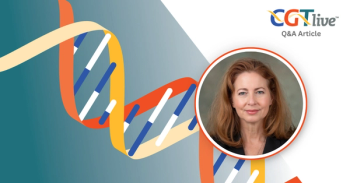
Lifileucel/Pembrolizumab Show Preliminary Promise for Advanced Melanoma
The combination of lifileucel and pembrolizumab was tolerable and led to responses for most patients with immune checkpoint inhibitor–naïve advanced melanoma.
The tumor-infiltrating lymphocyte (TIL) therapy lifileucel (LN-144) in combination with pembrolizumab (Keytruda) led to an overall response rate (ORR) of 85.7% for immune checkpoint inhibitor (ICI)–naïve patients with advanced melanoma, according to preliminary findings from cohort 1A of a phase 2 trial presented at the 2021 ASCO Annual Meeting.
There were 7 patients treated with the combination in the trial, with objective responses consisting evenly of complete responses (CRs) and unconfirmed CRs (n = 3) and partial responses (PR; n = 3). The remaining patients had stable disease at the time of disease assessment, which was conducted at day 84 following treatment. The overall disease control rate with lifileucel/pembrolizumab was 100%.
“These preliminary data suggest the response rate for lifileucel and pembrolizumab may be additive in patients with immune checkpoint inhibitor-naïve advanced melanoma,” lead study author Sajeve Samuel Thomas, MD, medical oncologist and hematologist at Orlando Health Cancer Institute in Florida, said during the meeting. “We are encouraged by these data showing the potential feasibility and activity of combination lifileucel and pembrolizumab in the early-line treatment of patients with advanced or metastatic melanoma.”
Lifileucel consists of autologous TILs that are harvested from tumor resections. The TILs are then expanded ex vivo and administered once enough cells have been reached in a centralized GMP facility. The full process took approximately 22 days. Prior to administration, patients received nonmyeloablative lymphodepleting cyclophosphamide and fludarabine. Lifileucel was administered as a single dose at a median of 27.3 x 10^9 cells. Up to 6 doses of IL-2 at 600,000 IU/kg were given to support immune expansion and proliferation.
Most patients enrolled in the study were treatment-naïve (n = 5), with the remaining 2 having received prior treatment with BRAF and MEK inhibitors (n = 1) and prior chemotherapy with prednisone (n = 1). The median age of patients was 52 years and at baseline 71.4% had liver/brain lesions and 42.9% had lactate dehydrogenase levels greater than the upper limit of normal. The mean target lesion sum of diameter was 111.4 mm, with 85.7% of patients having more than 3 target and non-target lesions, “representing advanced disease at baseline for this patient group,” Thomas said.
The median follow-up at the time of the analysis was 8.2 months and a median duration of response was not yet reached. The longest duration of response was 16.8 months and responses remained ongoing for most patients (57%). Three patients experience an 80% decrease in the sum diameters of their target lesions, and 1 patient, although not yet confirmed, experienced a 100% decline. The remaining 2 patients had approximately a 40% and a 60% decline in the sum of diameters.
PD-L1 status was available for 5 of the patients who responded, with CRs all experienced by patients with tumor proportion score (TPS) of ≥5%. In the 3 patients with CRs, a PR was seen shortly after month 1 that transitioned to a CR by month 6 for 2 of the patients and by month 11 for the third. Responses were ongoing for 4 of the patients, including the 3 who experienced a CR. Two of the patients had developed progressive disease at the time of the assessment.
Three patients who originally responded to therapy were no longer taking pembrolizumab due to adverse events (AEs) at 3 months, 4 months, and 13 months, respectively, although they continue to have a maintained response. The median number of pembrolizumab doses was 10. In general, the AE profile was consistent with the underlying disease and the known profiles of nonmyeloablative lymphodepletion, pembrolizumab, and lifileucel, Thomas noted. The frequency of AEs declined over time, which could be reflective of potential benefit for a 1-time dose of TILs, he added.
All patients reported at least 1 treatment-emergent AE (TEAE) in the study, with the most common of any grade being thrombocytopenia (100%), chills (85.7%), nausea (85.7%), pyrexia (85.7%), vomiting (85.7%), fatigue (71.4%), febrile neutropenia (71.4%), hypertension (57.1%), and neutropenia (57.1%). The most common grade 3/4 TEAEs were thrombocytopenia (85.7%), febrile neutropenia (71.4%), neutropenia (57.1%), hypertension (28.6%), and pyrexia (28.6%).
There were no grade 5 TEAEs during the study.
Enrollment into the phase 2 study remains ongoing. In addition to the combination cohort, the study is also exploring lifileucel as monotherapy for patients with melanoma. Additionally, the multicohort study is examining various combinations and the monotherapy in other types of tumors. Across all arms, the study plans to enroll 135 participants (NCT03645928).
Reference
Thomas SS, In KG, Doger B, et all. Safety and efficacy of lifileucel (LN-144), an autologous, tumor infiltrating lymphocyte cell therapy in combination with pembrolizumab for immune checkpoint inhibitor naïve patients with advanced melanoma. J Clin Oncol. 2021;39(suppl 15):9537.
Newsletter
Stay at the forefront of cutting-edge science with CGT—your direct line to expert insights, breakthrough data, and real-time coverage of the latest advancements in cell and gene therapy.


















































